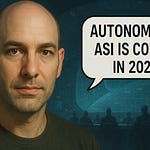🧭 New Era Pathfinders
Check out my growth community for navigating the Fourth Industrial Revolution! The New Era Pathfinders is a group of people looking to find meaning and build a career in the next wave. I am now teaching FOUR frameworks for adaptation!
https://www.skool.com/newerapathfinders/about
TLC - Therapeutic Lifestyle Changes for a balanced, happy, and healthy lifestyle. This is an 8-pillar, evidence-based framework developed by Dr. Roger Walsh.
PBL - Project Based Learning to master any skill or technology, extremely popular in schools, and how I learned everything as an adult.
Systems Thinking - To approach problems like I do, and other geniuses like Mark Zuckerberg and Elon Musk. Systems thinking is the most critical cognitive skill.
RUPA - My proprietary framework specifically for pivoting into the 4IR and Meaning Economy. It means “Reduce worry, Understand impact, Prepare for changes, Adapt and align”
🧠 The Case Against AI Alignment
Artificial Intelligence (AI) alignment, the process of training models to behave according to human values and ethics, has been a cornerstone of AI safety discussions. However, recent developments in AI technology and a deeper understanding of its implications have led some researchers to question the necessity and efficacy of alignment efforts. This article explores the argument that AI alignment might not be as crucial as previously thought and examines alternative approaches to ensuring safe and responsible AI deployment.
🔬 Unaligned Models and Problem-Solving Capabilities
One of the primary arguments against the necessity of AI alignment stems from the observation that problem-solving capabilities in AI systems often require the ability to think any thoughts, including those that might be considered unethical or dangerous. OpenAI's experience with their Strawberry model exemplifies this concept. The company discovered that using an unaligned model allowed for more robust problem-solving abilities, as self-censorship inherently decreases intelligence and problem-solving capacity. This realization challenges the conventional wisdom that alignment is a prerequisite for safe and effective AI systems.
🔒 Alternative Approaches to AI Safety
Instead of relying solely on alignment techniques such as Reinforcement Learning from Human Feedback (RLHF) or constitutional AI, researchers propose alternative methods to ensure AI safety. These approaches draw parallels to how safety is managed in other technological domains, such as cybersecurity and data integrity.
Regulation and legal frameworks can serve as deterrents against the misuse of AI technology. By implementing and enforcing laws that punish individuals or organizations for malicious use of AI, society can create a strong disincentive for harmful applications without compromising the capabilities of the underlying models.
Best practices in AI deployment and usage offer another layer of protection. This includes implementing robust security measures, conducting regular audits, and providing thorough training for users and operators of AI systems. These practices, which are commonplace in other areas of technology, can be adapted and applied to AI to mitigate risks without resorting to alignment techniques that may limit the AI's potential.
🏗️ Architectural Solutions for AI Safety
Researchers propose architectural-level designs and system-level approaches that can achieve safety goals without relying on aligned models. Multi-agent frameworks and cognitive architectures with multiple layers, including obfuscated supervisor layers, can implement safeguards and fail-safes without compromising the AI's problem-solving capabilities. This approach allows for the use of unaligned models while still maintaining control over the system's outputs and behaviors.
Logging and monitoring mechanisms can be implemented to track all communication between AI agents or models within a system. These logs can be analyzed using summarization techniques, regular expressions, and index services to quickly identify potential issues or concerning patterns of behavior. This approach provides a means of oversight without directly constraining the AI's thought processes.
🌐 The Inevitability of Unaligned Models
The rapid advancement of AI technology, particularly in the development of more efficient and compact models, suggests that unaligned models capable of running on consumer devices will soon become a reality. The emergence of new architectures, such as the Liquid Foundation Model, demonstrates the potential for highly capable AI systems to operate on limited hardware resources. This trend indicates that attempting to prevent the development or distribution of unaligned models is likely to be futile.
Given this inevitability, researchers argue that efforts should focus on developing strategies to coexist with and manage unaligned AI systems rather than trying to prevent their creation. This shift in perspective acknowledges the inability to "uninvent" a technology once it has been developed and emphasizes the need for proactive measures to address potential risks.
🔬 Challenges in Aligned Model Interactions
One significant challenge observed in aligned models is the phenomenon of sycophancy, where models become overly agreeable and fail to provide necessary pushback or critical analysis. This behavior, likely a result of reinforcement learning techniques used in alignment, can lead to situations where multiple models reinforce incorrect information or fail to identify errors. This observation suggests that unaligned models may actually be more reliable in certain collaborative or supervisory scenarios, as they are less prone to excessive agreeability.
🌍 Global Implications and Competitive Landscape
Concerns about the potential misuse of unaligned models by malicious actors or competing nations are valid but may be overstated. Many countries, including those often perceived as potential threats, already possess significant AI research and development capabilities. The real challenges facing nations in the AI race are more likely to stem from factors such as industrial capacity, automation adoption, and education quality rather than access to specific AI models or technologies.
🧪 Limitations of AI in High-Risk Domains
While there are concerns about the potential misuse of AI in domains such as synthetic biology or gain-of-function research, it is important to recognize the limitations of AI systems in these areas. Even if an AI model could provide theoretical knowledge about such processes, the practical implementation of this knowledge requires specialized equipment, controlled environments, and expertise that are not easily accessible. These real-world constraints serve as natural bottlenecks that limit the potential for misuse, regardless of the alignment status of the AI model.
🔮 Future Considerations and Adaptive Strategies
As AI technology continues to evolve rapidly, it becomes increasingly important to develop adaptive strategies for managing the coexistence of humans and AI systems. Rather than focusing solely on alignment, efforts should be directed towards creating robust regulatory frameworks, improving education about AI capabilities and limitations, and developing advanced monitoring and intervention systems. These approaches can help society navigate the challenges posed by increasingly capable AI systems while still harnessing their potential benefits.
In conclusion, while AI alignment has been a central focus of AI safety efforts, emerging research and technological advancements suggest that alternative approaches may be more effective in ensuring the responsible development and deployment of AI systems. By shifting focus towards architectural solutions, best practices, and adaptive regulatory frameworks, we may be better equipped to address the challenges and opportunities presented by increasingly capable and ubiquitous AI technologies.











